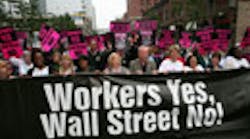The National Labor Relations Board (NLRB) published a final rule in the Federal Register on Dec. 22, 2011, that changes the union representation and election process in an effort to reduce “unnecessary litigation in representation cases,” NLRB said. The board also said the rule will save time and resources for both the parties involved and NLRB in resolving disputes.
“This NLRB rule is a modest but important first step toward ensuring a level playing field for workers in the union election process,” said Joe Hansen, International President of the United Food and Commercial Workers (UFCW) Union. “Preventing unnecessary delays and frivolous litigation means less time for employers to intimidate, harass, and in some cases fire pro-union employees. Every worker has the right to decide whether he or she wants a union, free of interference.”
UFCW represents more than 1.3 million workers, primarily in the retail and meatpacking, food processing and poultry industries.
But businesses are calling the rule an “ambush election rule” that serves only to further the proliferation of unions.
“The ambush election rule is a guaranteed pathway to creating a fractured American workplace,” said Jay Timmons, president & CEO of the National Assn. of Manufacturers (NAM). “Manufacturers strongly oppose this misguided rule. It is critical that employers have proper time to prepare for an upcoming union election and that workers have the needed time to get all the facts essential to making such an important decision.
According to a statement released by NAM, the final rule, set to go into effect on April 30, 2012, will “block manufacturers from communicating with their employees, alter what can and cannot be heard at a pre-election hearing and what can be appealed after a pre-election hearing, and shorten the time frame for elections.”
The NLRB, though, said the final rule will “focus pre-election hearings on those issues relevant to determining if there is a question concerning representation, provide for pre-election briefing only when it will assist the decision makers, and reduce piecemeal appeals to the board.”
It will also consolidate requests for board review of regional directors’ pre- and post-election determinations into a single, post-election request, make board review of post-election regional determinations discretionary, and eliminate duplicative regulations, the agency said.
“It’s good news that the NLRB has taken this modest but important step to help ensure that workers who want to vote to form a union at their workplace get a fair opportunity to do so,” said Richard Trumka, AFL-CIO president. “Many more improvements are needed to protect workers’ rights. We hope the board will quickly move to adopt the rest of its proposed reforms to modernize and streamline the election process.”
U.S. Rep. John Kline (R-MN), chairman of the U.S. House Education and the Workforce Committee, issued a stern statement chastising NLRB for pushing through the rule.
“Ignoring the will of Congress and objections raised by countless organizations representing workers and employers, the NLRB has chosen to deliver a final ambush election rule to its Big Labor allies - just in time for the holidays,” he said. “Although the scheme has been modified to remove some egregious provisions, it will still deny access to a fair election process, limit employer free speech, and restrict worker free choice. The Obama board’s rush to enact this rule before it loses its quorum confirms what my Republican colleagues and I have suspected all along – this board is not fighting for the best interests of our workforce, but instead is determined to advance an activist, pro-union agenda at any cost. Our nation’s workers and employers deserve better.”
Kline is part of a House group that passed the Workforce Democracy and Fairness Act in November. Under that plan, employers would have at least 14 days to prepare their case to present before a NLRB election officer and an opportunity to raise additional concerns throughout the pre-election hearing. It also guarantees that no union election will be held in less than 35 days; and reinstates the “traditional standard” for determining which employees will vote in the union election.
The rule covers a range of collective bargaining issues, including helping employees and their employer agree on whether employees should be represented for the purposes of collective bargaining.
One of the big issues around the rule is the speed at which the representation process occurs. Currently, once a petition is filed for representation, procedures, including the filing of legal briefs by both employees and employers, can delay the process. Once a regional director issues the call for an election, it is typically at least 25 days later before an election is conducted, allowing both sides the chance to respond.
This rule will create a “policy of expeditiously resolving questions concerning representation” and to better ensure “that employees’ votes may be recorded accurately, efficiently and speedily,” NLRB said.
Under the rule, employers and employees will now be able to file legal briefs post-election and those briefs will be consolidated with any additional post-election matters, speeding the path to election, NLRB said.
“The board has determined that amending the rules to give the hearing officer discretion to permit the filing of post-hearing briefs will eliminate unnecessary expense and delay,” it said. “Therefore, the board has determined that amending the rules to defer the right to file requests for review of the direction of the election until after the election and to eliminate the mandatory waiting period will eliminate unnecessary litigation and delay.”




